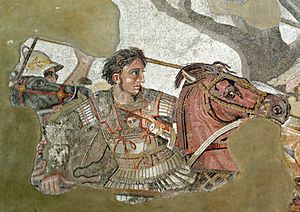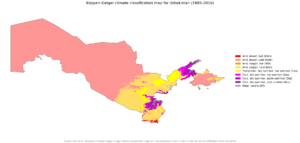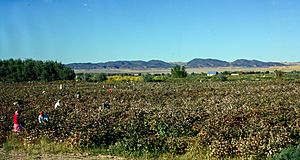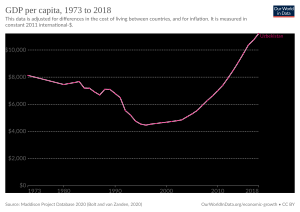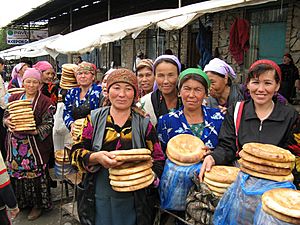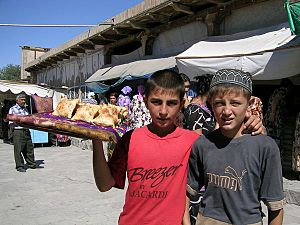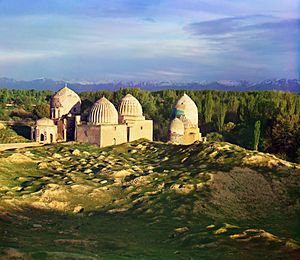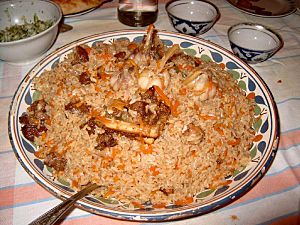Uzbekistan facts for kids
Quick facts for kids
Republic of Uzbekistan
O‘zbekiston Respublikasi,
Ўзбекистон Республикаси (Uzbek) |
|
|---|---|
|
|
|
|
Anthem:
O‘zbekiston Respublikasining Davlat Madhiyasi, Ўзбекистон Республикасининг Давлат Мадҳияси "State Anthem of the Republic of Uzbekistan" |
|
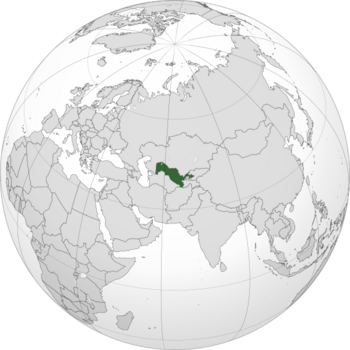
Location of Uzbekistan (green)
|
|
| Capital and largest city
|
Tashkent 41°19′N 69°16′E / 41.317°N 69.267°E |
| Official languages | Uzbek |
| Recognised regional languages | Karakalpak |
| Ethnic groups
(2021)
|
|
| Demonym(s) | Uzbekistani • Uzbek |
| Government | Unitary semi-presidential republic |
| Shavkat Mirziyoyev | |
| Abdulla Aripov | |
| Legislature | Oliy Majlis |
| Senate | |
| Legislative Chamber | |
| Formation | |
|
• Uzbek SSR established after national delimitation
|
27 October 1924 |
|
• Declared independence from the Soviet Union
|
1 September 1991 |
|
• Formally recognised
|
26 December 1991 |
|
• Current constitution
|
1 May 2023 |
| Area | |
|
• Total
|
447,400 km2 (172,700 sq mi) (55th) |
|
• Water (%)
|
4.9 |
| Population | |
|
• 2024 estimate
|
37,139,008 (36th) |
|
• Density
|
80.2/km2 (207.7/sq mi) (138th) |
| GDP (PPP) | 2024 estimate |
|
• Total
|
|
|
• Per capita
|
|
| GDP (nominal) | 2024 estimate |
|
• Total
|
|
|
• Per capita
|
|
| Gini (2013) | ▼ 36.7 medium |
| HDI (2022) | high · 106th |
| Currency | Uzbek sum (UZS) |
| Time zone | UTC+5 (UZT) |
| Date format | dd/mm yyyyc |
| Driving side | right |
| Calling code | +998 |
| ISO 3166 code | UZ |
| Internet TLD | .uz |
|
|
Uzbekistan, officially called the Republic of Uzbekistan, is a country in Central Asia. It is surrounded by five other countries: Kazakhstan to the north, Kyrgyzstan to the northeast, Tajikistan to the southeast, Afghanistan to the south, and Turkmenistan to the southwest. Uzbekistan is part of the Turkic world, which means its culture and languages are related to other Turkic countries. It is also a member of the Organization of Turkic States.
The main language spoken is Uzbek, but Russian is also widely used and understood. Most people in Uzbekistan follow the Islamic religion, specifically Sunni Muslim.
The first people to settle in this area were Eastern Iranian nomads called Scythians. They built kingdoms around 8th to 6th centuries BC. Later, the region became part of big empires like the Achaemenid Empire and the Sasanian Empire. In the 7th century, Muslims arrived and brought Islam to the region. Cities along the Silk Road became very rich and important centers during the Islamic Golden Age.
In the 13th century, the Mongols invaded, which led to Turkic people becoming more dominant. Later, in the 14th century, a powerful leader named Timur (also known as Tamerlane) created the Timurid Empire. His capital, Samarkand, became a hub for science and culture, leading to the Timurid Renaissance.
In the 16th century, the Uzbek Shaybanids took over the Timurid lands. One leader, Babur, went east and founded the Mughal Empire in India. In the 19th century, the Russian Empire slowly took control of Central Asia, and Tashkent became a key city. In 1924, Uzbekistan became the Uzbek Soviet Socialist Republic, a part of the Soviet Union. Finally, in 1991, Uzbekistan declared its independence.
Contents
What's in a Name?
The name "Uzbegistán" was first seen in a book called Tarikh-i Rashidi in the 16th century.
The exact meaning of the word "Uzbek" is still debated. Some ideas include:
- It means "free" or "independent," combining the Turkic words uz (meaning "own") and bek (meaning "master" or "leader").
- It might be named after Oghuz Khagan, who was also called Oghuz Beg.
- It could be a shorter version of Uğuz or Oğuz (referring to the Oghuz (tribe) people), combined with bek ("leader").
All these ideas connect to the Turkic word Beg, which means "leader" or "master."
A Look at Uzbekistan's Past
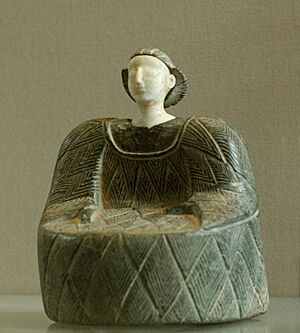
The first people known to live in Central Asia were the Scythians. They arrived from the northern grasslands around 1000 BC. These nomads settled down and built large irrigation systems along the rivers. Cities like Bukhara and Samarkand grew into important centers for government and culture. By the 5th century BC, states like Bactria and Sogdia were powerful in the region.
As trade developed between East Asia and the West, using the Silk Road, the Sogdian merchants became very rich. This trade made Bukhara and Samarkand wealthy cities. The area known as Transoxiana became one of the most important and powerful regions in ancient times.
In 327 BC, Alexander the Great from Macedonia conquered the Persian provinces of Sogdiana and Bactria, which included modern Uzbekistan. The local people fought back strongly. Later, the Kushan Empire took over. For many centuries, the region was ruled by empires like the Parthian Empire and Sasanian Empire, and also by Turkic groups like the Gokturks.
The Arrival of Islam
From the 7th century onwards, Arabs brought Islam to Uzbekistan. During this time, Islam also began to spread among the nomadic Turkic people. By the 8th century, the Arabs had conquered Transoxiana, the land between the Amudarya and Syrdarya rivers. This area soon became a key place during the Islamic Golden Age.
In the 9th and 10th centuries, Transoxiana was part of the Samanid Empire. After that, Turkic groups like the Karakhanids and Seljuks came into the region.
Mongol Rule and Timur's Empire
The Mongol invasion led by Genghis Khan in the 13th century changed the region greatly. Cities like Bukhara and Samarkand faced massive destruction. After Genghis Khan died in 1227, his empire was divided among his sons. Most of Transoxiana was controlled by the descendants of Chagatai Khan.
Later, in the early 14th century, the Mongol Empire started to break apart. A tribal leader named Timur (Tamerlane) became the most powerful force in Transoxiana in the 1380s. Even though he wasn't a descendant of Genghis Khan, Timur conquered a huge area, including all of western Central Asia, Iran, and parts of Russia. He died in 1405 during an invasion of China.
Timur made his capital, Samarkand, a center of art and learning. He brought many skilled workers and scholars from the lands he conquered. This created a rich Perso-Islamic culture in his empire. Many beautiful religious buildings and palaces were built in Samarkand. Timur's grandson, Ulugh Beg, was one of the world's first great astronomers. During the Timurid period, the Chaghatai dialect of Turkic became an important literary language.
Later Dynasties and Russian Influence
After Timur's death, his state quickly split. The fighting among the Timurids attracted the attention of Uzbek nomadic tribes from the north. In 1501, these Uzbek forces began a full invasion of Transoxiana. Before the Russians arrived, present-day Uzbekistan was divided into different states, including the Emirate of Bukhara and the khanates of Khiva and Kokand.
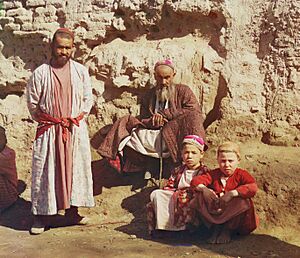
In the 19th century, the Russian Empire started to expand into Central Asia. This period was sometimes called the "Great Game" because of the competition between Russia and Britain. By the early 1920s, Russia had firm control over Central Asia. On October 27, 1924, the Uzbek Soviet Socialist Republic was formed as part of the Soviet Union. During World War II, many people from Uzbekistan fought in the Red Army.
On June 20, 1990, Uzbekistan declared its independence. On August 31, 1991, it officially became the Republic of Uzbekistan after a failed coup attempt in Moscow. September 1st is now celebrated as National Independence Day. Islam Karimov became the first president of independent Uzbekistan. After he died in 2016, Shavkat Mirziyoyev became the new president.
Uzbekistan's Geography
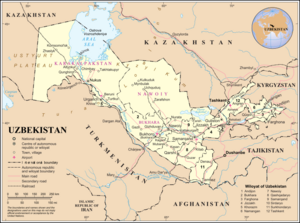
Uzbekistan covers an area of about 448,978 square kilometers (173,348 square miles). It is the 56th largest country in the world by size. Among the CIS countries, it is the fourth largest by area.
Uzbekistan shares borders with Kazakhstan to the north, Turkmenistan and Afghanistan to the southwest, Tajikistan to the southeast, and Kyrgyzstan to the northeast. It is the only Central Asian country that borders all the other four. It also has a short border with Afghanistan in the south.
Uzbekistan is a hot, dry country that is landlocked. This means it has no direct access to the sea. In fact, it's one of only two "doubly landlocked" countries in the world. This means it is completely surrounded by other landlocked countries. Also, none of its rivers flow into the ocean. Less than 10% of its land is used for farming, mostly in river valleys and oases. The rest of the country is covered by the huge Kyzylkum Desert and mountains.
The highest point in Uzbekistan is Khazret Sultan, which is 4,643 meters (15,233 feet) above sea level. It is located in the southern part of the Gissar Range, near the border with Tajikistan.
Uzbekistan has a continental climate. This means it has very little rain, usually only 100–200 millimeters (3.9–7.9 inches) per year. Summer temperatures can reach 40 °C (104 °F), while winter temperatures can drop to around −23 °C (−9 °F).
Environmental Challenges
Uzbekistan has a rich natural environment. However, past policies from the Soviet Union focused heavily on growing cotton. This has caused serious environmental problems, especially with air and water pollution.
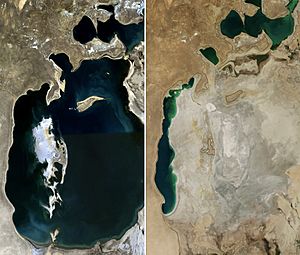
The Aral Sea was once the fourth-largest inland sea on Earth. It helped keep the air moist and watered the dry land. But since the 1960s, too much water has been taken from the Aral Sea, mainly for irrigating cotton fields. Cotton needs a lot of water to grow. As a result, the Aral Sea has shrunk to about 10% of its original size.
Because the Aral Sea has shrunk, the soil in nearby areas like Karakalpakstan has become very salty and polluted with heavy elements. Most of the country's water is still used for farming, which causes high soil salinity. Also, using a lot of pesticides and fertilizers for cotton makes the soil even more polluted.
Uzbekistan also experiences earthquakes. Some notable ones include the 1902 Andijan earthquake, the 2011 Fergana Valley earthquake, and the 1966 Tashkent earthquake.
How Uzbekistan is Divided
Uzbekistan is divided into twelve regions, which are called viloyatlar. It also has one autonomous republic called Republic of Karakalpakstan, and one independent city, which is Tashkent.

| Division | Capital City | Area (km2) |
Population (2022) |
Key |
|---|---|---|---|---|
| Andijan Region Uzbek: Андижон вилояти/Andijon Viloyati |
Andijan Andijon |
4,303 | 3,253,528 | 2 |
| Bukhara Region Uzbek: Бухоро вилояти/Buxoro Viloyati |
Bukhara Buxoro |
41,937 | 1,976,823 | 3 |
| Fergana Region Uzbek: Фарғона вилояти/Fargʻona Viloyati |
Fergana Fargʻona |
7,005 | 3,896,395 | 4 |
| Jizzakh Region Uzbek: Жиззах вилояти/Jizzax Viloyati |
Jizzakh Jizzax |
21,179 | 1,443,408 | 5 |
| Republic of Karakalpakstan Karakalpak: Қарақалпақстан Республикасы/Qaraqalpaqstan Respublikasiʻ Uzbek: Қорақалпоғистон Республикаси/Qoraqalpogʻiston Respublikasi |
Nukus No‘kis Nukus |
161,358 | 1,948,488 | 14 |
| Kashkadarya Region Uzbek: Қашқадарё вилояти/Qashqadaryo Viloyati |
Karshi Qarshi |
28,568 | 3,408,345 | 8 |
| Khorezm Region Uzbek: Хоразм вилояти/Xorazm Viloyati |
Urgench Urganch |
6,464 | 1,924,163 | 13 |
| Namangan Region Uzbek: Наманган вилояти/Namangan Viloyati |
Namangan Namangan |
7,181 | 2,931,056 | 6 |
| Navoiy Region Uzbek: Навоий вилояти/Navoiy Viloyati |
Navoiy Navoiy |
109,375 | 1,033,857 | 7 |
| Samarkand Region Uzbek: Самарқанд вилояти/Samarqand Viloyati |
Samarkand Samarqand |
16,773 | 4,031,324 | 9 |
| Surkhandarya Region Uzbek: Сурхондарё вилояти/Surxondaryo Viloyati |
Termez Termiz |
20,099 | 2,743,201 | 11 |
| Syrdarya Region Uzbek: Сирдарё вилояти/Sirdaryo Viloyati |
Gulistan Guliston |
4,276 | 878,591 | 10 |
| Tashkent City Uzbek:Тошкент/Toshkent Shahri |
Tashkent Toshkent |
327 | 2,860,595 | 1 |
| Tashkent Region Uzbek: Тошкент вилояти/Toshkent Viloyati |
Nurafshon Nurafshon |
15,258 | 2,941,522 | 12 |
These regions are then divided into smaller areas called districts (tuman).
Major Cities
|
Largest cities or towns in Uzbekistan
|
||
|---|---|---|
| Rank | Name | Pop. |
| 1 | Tashkent | 2,571,668 |
| 2 | Namangan | 678,200 |
| 3 | Samarkand | 573,200 |
| 4 | Andijan | 468,100 |
| 5 | Nukus | 310,000 |
| 6 | Fergana | 299,000 |
| 7 | Bukhara | 285,000 |
| 8 | Qarshi | 260,000 |
| 9 | Kokand | 260,000 |
| 10 | Margilan | 242,500 |
Uzbekistan's Economy
Uzbekistan is rich in natural resources. It mines 80 tons of gold every year, making it the seventh-largest gold producer in the world. Its copper deposits rank tenth globally, and its uranium deposits twelfth. The country is also the seventh-largest producer of uranium worldwide.
The Uzbek national gas company, Uzbekneftegaz, is the 11th largest in the world for natural gas production. Uzbekistan has many untapped oil and gas reserves, with 194 known deposits.
In 2011, Uzbekistan was the world's seventh-largest producer and fifth-largest exporter of cotton. It was also the seventh-largest producer of gold. The country is also an important producer of natural gas, coal, copper, oil, and silver in its region.
Farming employs 27% of Uzbekistan's workers and makes up 17.4% of its GDP (as of 2012). The country also produces a lot of carrots.
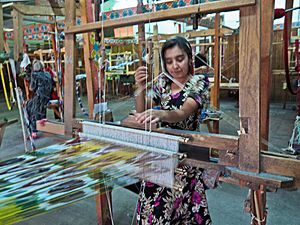
The government of Uzbekistan has rules that limit foreign imports, like high import taxes. This helps protect goods made in Uzbekistan. In 2023, Uzbekistan was ranked 82nd in the Global Innovation Index.
People of Uzbekistan
| Population | |||
|---|---|---|---|
| Year | Million | ||
| 1950 | 6.2 | ||
| 2000 | 24.8 | ||
| 2018 | 32.5 | ||
| 2023 | 36.2 | ||
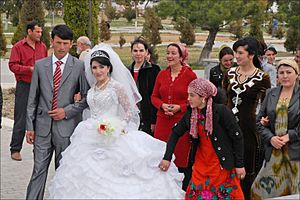
As of 2022, Uzbekistan has the largest population in Central Asia, with 36 million people. This is almost half of the region's total population. Many people in Uzbekistan are young: about 34.1% are younger than 14 (2008 estimate). Most of the population (84.5%) are Uzbeks. Other groups include Russians (2.1%), Tajiks (4.8%), Kazakhs (2.4%), Karakalpaks (2.2%), and Tatars (0.5%) as of 2021.
About 10% of Uzbekistan's workers go abroad for jobs, mostly to Russia and Kazakhstan. Life expectancy in Uzbekistan is 66 years for men and 72 years for women.
Religion in Uzbekistan

Uzbekistan is a country where the government and religion are separate. Article 61 of its constitution says that religious groups are equal before the law and the state will not interfere with their activities. Islam is the main religion in Uzbekistan.
Languages Spoken

The Uzbek language is a Turkic language. It is the only official national language, and since 1992, it has been officially written using the Latin alphabet.
Even though Russian is not an official language, it is widely used in many areas. Government information is often available in both Uzbek and Russian. About one million people in the country speak Russian as their first language. Signs across the country are in both Uzbek and Russian.
The Tajik language (a type of Persian) is common in cities like Bukhara and Samarkand. This is because many ethnic Tajiks live there. It is also found in other areas, making up about 10–15% of Uzbekistan's population. There are no language tests to become a citizen of Uzbekistan.
Music and Culture
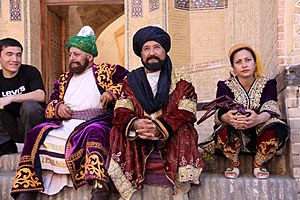
Central Asian classical music is called Shashmaqam. It started in Bukhara in the late 16th century. Shashmaqam is similar to Azerbaijani Mugam and Uyghur muqam. The name means "six maqams," referring to the music's structure with six sections in different musical modes. Spoken Sufi poetry is often included in the music.
Education System
Students in Uzbekistan go to school from Monday to Saturday during the school year. Education officially finishes at the end of the 11th grade.
Several universities in Tashkent offer courses in English. These include Westminster University, Turin University, Management University Institute of Singapore, Bucheon University, TEAM University, and Inha University Tashkent. Many national universities also offer Russian-language higher education. Some foreign universities, like Moscow State University, have campuses in Tashkent.
There are also three Islamic institutes and an academy in Uzbekistan. These are Tashkent islamic institute, Mir Arab high school, School of hadith knowledge, and International islamic academy of Uzbekistan.
Delicious Uzbek Food
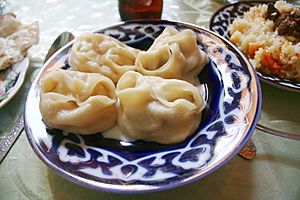
Uzbek food is shaped by local agriculture. Since a lot of grain is grown, bread and noodles are very important. Uzbek cuisine is known for being "noodle-rich." Mutton (sheep meat) is a popular choice because there are many sheep in the country. It is used in many Uzbek dishes.
Uzbekistan's most famous dish is palov (or plov). It's a main course usually made with rice, meat, carrots, and onions. There are many different ways to make palov in different regions. Green tea is the national hot drink and is enjoyed all day. Teahouses (chaikhanas) are important cultural places. Tea is always served with meals and offered to guests as a sign of hospitality. Ayran, a cold yogurt drink, is popular in summer.
Sports in Uzbekistan
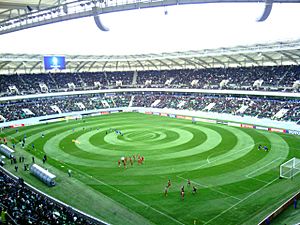
Uzbekistan has produced famous athletes. Djamolidine Abdoujaparov is a former racing cyclist who won the green jersey points contest in the Tour de France three times. He was known for his powerful sprints and was nicknamed 'The Terror of Tashkent'.
Artur Taymazov won Uzbekistan's first Olympic wrestling medal in 2000. He later won three Olympic gold medals in wrestling. However, some of his gold medals were taken away after re-testing of samples.
Ruslan Chagaev is a former professional boxer from Uzbekistan. He won the WBA champion title in 2007. Another talented boxer, Hasanboy Dusmatov, won a gold medal at the 2016 Summer Olympics in light flyweight boxing.
Michael Kolganov, an Uzbek-born sprint canoer, won a world championship and an Olympic bronze medal for Israel. Gymnast Alexander Shatilov, also an Uzbek émigré, won world bronze medals for Israel. Oksana Chusovitina, an artistic gymnast, has competed in eight Olympic games and won many medals for different countries, including Uzbekistan.
Uzbekistan is home to the International Kurash Association. Kurash is a modern form of traditional Uzbek wrestling.
Football is the most popular sport in Uzbekistan. The top league is the Uzbekistan Super League. FC Pakhtakor holds the record for the most championship titles. Uzbek football clubs often play in international competitions like the AFC Champions League. FC Nasaf Qarashi won the 2011 AFC Cup in 2011, which was the first international club cup for Uzbek football.
Humo Tashkent is a professional ice hockey team started in 2019. They play at the Humo Ice Dome. The Uzbekistan Hockey Federation is working to form a national ice hockey team to join international competitions.
Before Uzbekistan became independent in 1991, its athletes were part of Soviet Union national teams for sports like football, rugby, basketball, and ice hockey. After independence, Uzbekistan created its own national teams.
Tennis is also very popular in Uzbekistan. The Uzbekistan Tennis Federation (UTF) was created in 2002. Uzbekistan hosts an international WTA tennis tournament called the "Tashkent Open." Famous Uzbek tennis players include Denis Istomin and Akgul Amanmuradova.
Chess is quite popular in Uzbekistan. Rustam Kasimdzhanov was the FIDE World Chess Champion in 2004. Young players like Nodirbek Abdusattorov are also making a name for themselves, with Nodirbek winning the World Rapid Chess Champion title in 2021. In 2022, the Uzbek chess team won gold at the 44th Chess Olympiad.
Other popular sports in Uzbekistan include basketball, judo, team handball, baseball, taekwondo, and futsal. Ulugbek Rashitov won Uzbekistan's first Olympic gold medal in taekwondo at the Tokyo 2021 Summer Olympic Games. In 2022, the 2022 World Judo Championships were held in Tashkent. Uzbekistan will host the 2024 FIFA Futsal World Cup in 2024.
Fun Facts About Uzbekistan
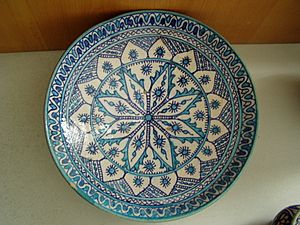
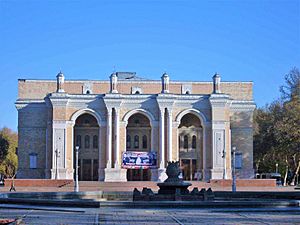
- Two major Uzbek cities, Bukhara and Samarkand, were once important stops on the famous Silk Road.
- Uzbekistan is a big producer and exporter of cotton.
- Uzbek cotton is even used to make banknotes in South Korea.
- Uzbekistan has a very high literacy rate, with 99.9% of adults over 15 able to read and write.
- Uzbekistan is a secular state, meaning the government and religion are separate. It has a presidential constitutional government.
- Experts predict that Uzbekistan will be one of the fastest-growing economies in the world in the coming decades.
Images for kids
-
Russian troops taking Samarkand in 1868, by Nikolay Karazin.
See also
 In Spanish: Uzbekistán para niños
In Spanish: Uzbekistán para niños




